A well-maintained and well-manicured lawn is one of the best ways to increase your home’s curb appeal. However, creating and keeping your yard in good shape is no easy task. It involves regularly watering, fertilizing, and mowing the grass.
Lawn mowing is more time-consuming than any other lawn task. And, for someone new to lawn care, one of the most common questions is: what height should I cut my grass?
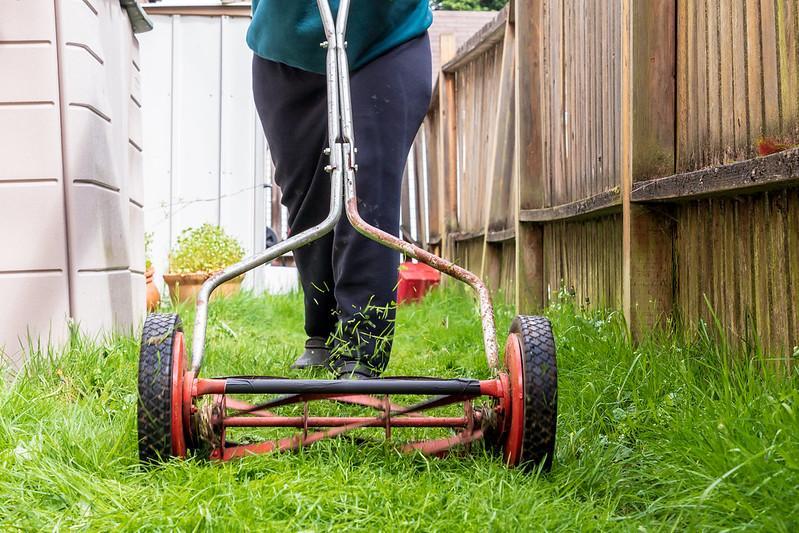
The ideal mowing height of your lawn depends on your climate and turfgrass type.
Ideal mowing height is a compromise between allowing the grass enough leaf length to be healthy and maintaining the wonderful lawn you want. And please forget the lawn myth that says: the shorter you mow your grass, the less often you’ll have to cut it.
Every grass has its ideal mowing height, which should be considered when cutting it. This height is usually between 2 and 3.75 inches for most lawn grasses.
Nevertheless, there is much more to cutting your grass at the ideal height.
Continue reading to find out!
RELATED: Grasses That Can Be Planted And Grown In Fall & Winter | Our Top Picks
First, The Anatomy Of Grass
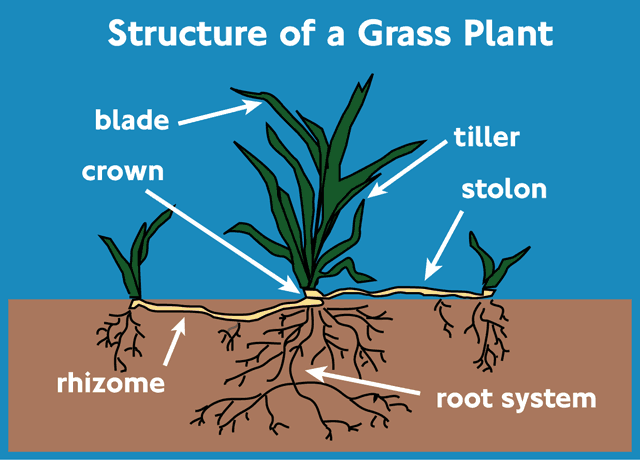
Grasses have long leaves, thin roots, a rounded stem (often hollow), and a flowering spike.
Before we discuss the best mowing height for different grass types, let’s quickly discuss the anatomy of a grass plant. It will help you understand why cutting at the right height matters and what will or could happen to your lawn if you mow at an incorrect height.
The body of a grass plant can be divided into two parts. First is the above-ground part, which consists primarily of grass blades and stolons (above-ground stems). The second part is the underground part which consists of rhizomes (subterranean stems) and the root system.
Depending on the grass type, the exact structure of these parts and their dimensions will vary. For example, some grasses, such as Bermuda and Fescue grass, have thin blades. In contrast, other grass types like St. Augustine and Centipede grass have wide blades.
Why Does The Right Height Matter?
However, all grasses have one thing in common. They use their above-ground and below-ground parts together to grow and spread. For example, grass plants get their nutrients, water, and building blocks (besides carbon) from the soil through their roots. But the grass plans cannot use their nutrients or turn them into biomass without sunlight.
And that is where the above-ground part of a grass plant comes in.
The grass cannot use any of the things it collects unless it has the sun’s energy to convert them into biomolecules and sugars, which it uses for its growth. And to collect the sun’s energy, the grass needs its blades to gather the sunlight.
So, if you cut the grass blades too short, the grass leaves will not have enough surface area to collect the sunlight and, thus, will not grow even if it has access to sufficient nutrients and water. Likewise, if you let the grass blade grow too long, the root system of the grass might not be able to keep up with the nutrient and water supply for the whole plant.
A Rule Of Thumb For Cutting The Grass
While there is a correct height for cutting or mowing each grass type, you can follow this general rule of thumb to cut the grass whenever in doubt. It is called the one-third rule, meaning when cutting your grass, only trim the above on-third part of the blade.
I strongly advise that you adhere to this general rule of thumb, especially during the fall and winter. In summer, however, you can let the grass grow a bit longer before cutting the blades. It will save the soil and young grass from the summer heat.
The rule also holds when you know the right height to cut your grass. For example, if the ideal mowing height for your lawn is 2 inches, you should let the grass grow to a height of about 3 inches before going over your yard with your lawn mower machine.
Ideal Cutting Height For Various Types Of Grass

Experts suggest keeping your lawn about two and a half inches tall through most of the year.
It does not matter whether you have a lawn made-up of warm-season grass in Phoenix or a cool-season grass yard in Minnesota; every grass has an ideal mowing height. And, if you want to keep your lawn healthy, lush, and pest free, you’d mow it at the right length.
Grass left too long runs the risk of creating a perfect hiding place for insects such as fleas, mosquitos, and other animal critters such as moles, gophers, and snakes. In addition, it creates more work as long grass is harder to mow and needs to be bagged or mulched after the trim as it cannot be left on the lawn like shorter grass clippings.
In contrast, if you mow your grass too short, the lawn becomes susceptible to weed and pest invasion. Furthermore, short grass will expose the soil much more to direct sunlight, resulting in your yard drying up more quickly. As a result, you will have to water the lawn more than needed, increasing your work and lawn care-related expenses.
So, it is worth the effort to determine and mow your grass at the right height.
Ideal Mowing Height For Cool-Season Grasses
Cool-season grasses include Kentucky Bluegrass, Fescue Grass, and Perennial Ryegrass. These grasses reach peak growth during the cooler temperatures of fall and winter.
While the ideal mowing height for each grass varies, cool-season grasses are best mowed at heights of about one to four inches. Below are the recommended cutting heights of some of the commonly used cool-season grasses across North America:
- Tall fescue: 1.5 to 4 inches
- Perennial ryegrass: 0.75 to 2.5 inches
- Kentucky bluegrass: 0.75 to 3.5 inches
- Fine fescue: 1.5 to 4 inches
Ideal Mowing Height For Warm-Season Grasses
Warm-season grasses include St. Augustine grass, Bermuda grass, Centipede grass, and Zoysia grass. These grasses reach their peak growth during the warmer temperatures of the spring and summer.
Like cool-season grasses, ideal mowing height will vary for each grass and may even vary among the different cultivars. Nevertheless, the suggested cutting height for most warm-season grasses falls between 1 and 3 inches. Below are a few examples:
- Zoysia grass: 0.5 to 3 inches
- St. Augustine grass: 1 to 3 inches
- Kikuyu grass: 1 to 1.5 inches
- Centipede grass: 1 to 2.5 inches
- Buffalo grass: 1.5 to 3 inches
- Bermuda grass: 0.5 to 2.5 inches
- Bahia grass: 2 to 3 inches
RELATED: How To Remove Grass From A Yard To Start A New Garden? A Comprehensive Guide
Leave The Grass Clippings On The Lawn
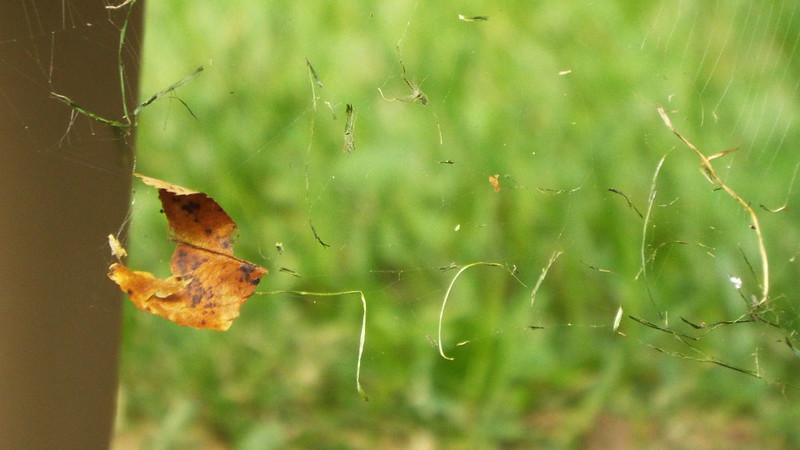
Grass clippings returned to the soil can provide up to 50% of your lawn’s total fertilizer needs.
Unless you let the grass grow too long or your grass clippings are in excessively thick clumps, leaving grass clippings on the lawn is a fantastic way to return nutrients to the soil and decrease fertilizer needs. According to the research conducted by Oregon State University, you can cut the fertilizer application rate almost in half if you return them to your lawn. However, it would help if you used a mowing mulcher to achieve this rate.
Furthermore, in addition to returning nutrients to the soil, leaving grass clippings on the lawn will reduce the time you spend mowing your lawn. Depending on how you recycle your lawn waste, it can also prevent the grass clippings from ending up in local landfills.
Also, please remember if you want to leave the grass clippings on your lawn, you will need to mow your yard much more frequently at the recommended cutting height. If you wait too long between cuttings, the grass clippings will be lengthier and harder to recycle.
However, keep the one-third rule in mind when mowing for recycling the clippings.
Don’t Mow Too Low To The Ground
Grass cut too short is much more likely to be stressed and invaded by lawn pests such as weeds as it thins out in places and gets exposed to sunlight and direct heat. The technical term for cutting your lawn too short is known as scalping in the gardening world.
When you cut the grass too short, the plant cannot get enough sunlight to make its biomolecules and create food for itself. As a result, it weakens and becomes vulnerable to pests. Moreover, when the grass is cut too short, the plant diverts all of its energy toward growing more leaf blades instead of other tasks, such as root growth.
When this happens, the grass might end up with a shallow root system, making the lawn much more vulnerable to drought stress and nutritional deficiencies. Mowing the grass too short could also result in your yard developing Brown Stripe Syndrome.
Brown Stripe Syndrome
The blades of grass originate from a single stop on the stem known as the crown.
When you mow your grass too short, you might remove too many grass blades from the plant, exposing the main stem, which in many cases is straw-colored and not green.
As a result, you might have yellow and brown spots on your lawn, known as the Brown Stripe Syndrome. However, it is not something that you cannot fix. All you need to do is raise your mowing height a bit, and soon these brown stripes will disappear.
Adjusting The Lawn Mower Height
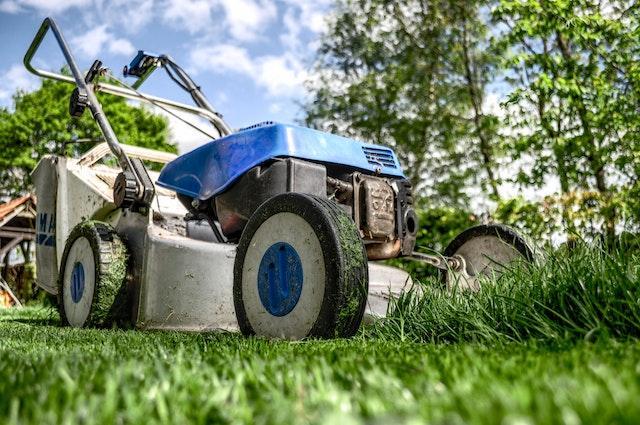
For a healthy lawn, follow the rule of one-third when setting your mowing height.
Now that you know pretty much everything there is to know about the correct height at which you should mow your lawn, let’s talk about some mowing basics. We will start with the most basic, i.e., adjusting the height setting on your lawn mower machine.
Depending on the model and type of lawn mower, the adjusting mechanism will be different. For example, in the case of push lawnmowers, you have manual height adjustment options where you need to raise or lower the height of each wheel separately.
In contrast, lawn tractors or walk-behind lawnmowers come with an automatic height adjustment system which a hydraulic or mechanical lever to lower or raise the height of the mowing deck. The height range will also vary from the mower to mower.
So, when trying to adjust the height of your mowing machine, I highly recommend you consult the manual first. It will have all the necessary information regarding height adjustment and some troubleshooting guides if you make a mistake.
Keep Your Mower Blade Sharp

Sharpen the blade twice each season to help maintain a green, lush, healthy lawn.
Even if you determine the correct mowing height for your grass and adjust your lawn mower accordingly, it could be all in vain if your lawn mower’s blade is not sharpened and dull.
A dull lawn mower blade can rip the grass blades apart, especially when mowing long grass, and it may also cause the grass to look brown in some spots. Moreover, ripped apart jagged grass not only looks ugly but is also more vulnerable to lawn diseases.
Not only that, but a dull lawn mower blade can also pull the grass from the soil, ruining the yard you worked so hard to build and maintain. Therefore, lawn experts often suggest sharpening the mower blade at least twice a year when regularly mowing.
If you are handy, you can even do it at home using a bench grinder, a grinder stone, or a grinding file. However, if that is not your thing, you can always find replacement blades for your lawn mower online or at the local gardening hardware store.
Lastly, if you use a powered lawn mower, please remove the electric or spark plug when performing maintenance or replacing worn-out machine parts.
When Should You Mow Your Lawn?
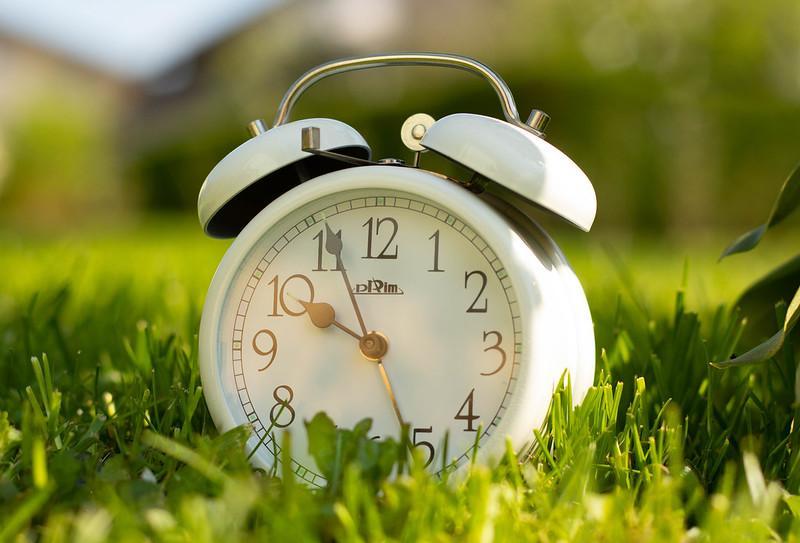
Most pros agree that mid-morning is the optimum time to mow the lawn for the best results.
There are varying opinions on the best time to mow your lawn. Some experts say it does not matter when you mow your lawn, while others say it does. So, let’s divide a day into different parts and see the pros and cons of cutting the grass at those times.
Should you mow in the early morning? In my opinion, mowing your lawn early in the morning is the worst. Your yard will likely be covered with dew, making it hard for the mower to cut the grass as the blades will slip, tearing the grass blades apart.
How about mowing the lawn in the mid-morning? Most experts agree that mowing the lawn in mid-morning is probably the best. The morning sun would have evaporated any dew from the grass, and the temperature would be mild so that you could mow easily.
Can you mow the lawn in the midday or afternoon? If because for some reason, you cannot cut your property in the morning, you should probably do it in the afternoon or noon. However, ensure it isn’t too hot, or you might burn the grass.
Should you mow your lawn in the evening? Mowing grass in the evening is probably as bad as trimming it in the early mornings. When the night starts settling in, so does the dew, which will cause the mower to work improperly on the lawn.
RELATED: How To Trim Extremely Long Grass? A Comprehensive Guide
Benefits Of Mowing The Lawn At The Right Height
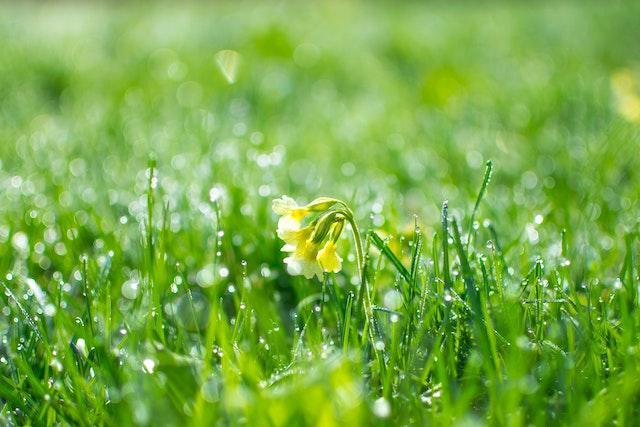
Grass cut at the right height is healthy, and it supports healthy honey bee colonies.
You may think the benefits of cutting your grass at the right height are only limited to the health and well-being of your lawn, but you would be wrong. Cutting the grass at the correct size creates a healthy yard, and its benefits reach beyond your property.
For example, a healthy lawn is a crucial part of a healthy biological ecosystem and has many positive environmental effects. Take, for example:
- A healthy lawn creates healthy honey bee colonies, which are crucial for pollination.
- Healthy lawns provide a cooling effect, meaning you will need to spend much less on energy systems and air conditioners to cool surroundings.
- A healthy lawn absorbs toxins from the environment, creating a healthy ecosystem.
Final Thoughts
Once again, when mowing a lawn, know the ideal cutting height for your grass type, and never trim more than one-third of the grass blade in any single trimming session.
If ever in doubt, I recommend you mow high and not scalp the lawn.
If you have shady spots on your lawn, let the grass grow a bit long in those regions so that plants have enough sunlight to go by. Moreover, if moss is present on your lawn, please ensure you cut about half an inch above the moss level when mowing.
Lastly, if possible, mow at right angles each time. Cutting the grass this way will prevent soil compaction and ensure you do not scalp your lawn over time.
Frequently Asked Questions
How Do You Measure the Height of Grass?
You can measure the height of your grass using a simple tape measure, starting from the grass plant’s base to the blade tips. However, when calculating the grass length, do so in many spots on your lawn and then average the readings for accuracy.
How Does Grass Height Change in Season?
The growth of the grass does not remain constant throughout the year; it keeps changing. Depending on the type of grass you have (warm-season or cool-season), the grass will reach its peak growth during warmer or colder months, and you will have to adjust the mowing height and mowing frequency accordingly if you want a healthy lawn.
Does the Type of Grass Impact Cutting Height?
The cutting height of the grass is affected significantly by the type of grass used to create a lawn. Every grass has its own unique mowing needs. However, warm-season grasses are cut higher (1 to 4 inches) than their cool-season counterparts (1 to 3 inches).
What is the best height to cut grass in summer?
The best height to cut the grass in summer will vary from grass type to type. However, experts usually agree that you should mow a bit high in the summer to save your grass from the impact of direct sunlight and heat, which will make the lawn dry.
Does grass grow faster the shorter you cut it?
Grass grows faster once you cut it short as the plant tries to make up for the lost grass blades that it needs to collect the sunlight. However, it would help if you did not mow your grass short very often, as you might end up scalping the lawn and killing the grass.
Sources For Further Reading
Adjust mowing frequency, cutting height on bermudagrass lawns – Oklahoma State University. (2020). Retrieved 4 February 2023, from https://news.okstate.edu/articles/agriculture/2020/stotts_bermudagrass-mowing.html
No Lawn Mowers Needed in… | The University of Northwestern, St. Paul. (2023). Retrieved 4 February 2023, from https://unwsp.edu/blog/no-lawnmowers-needed-in-december/
Mowing | General Lawn Maintenance | Lawn Problem Solver | Kansas State University. (2023). Retrieved 4 February 2023, from https://www.k-state.edu/turf/resources/lawn-problem-solver/maintenance/mowing/
Guidelines for Mowing Lawns Properly – Lawn Talk- The University of Illinois Extension. (2023). Retrieved 4 February 2023, from https://web.extension.illinois.edu/lawntalk/planting/guidelines_for_mowing_lawns.cfm
Thank you for reading this article on what height should I cut my grass. Also, check out our other articles:
What Are Different Bermuda Grass Types, And Which Is Best For A Lawn?
Crabgrass Vs. Quackgrass | How To Tell The Difference & Which Is Worse?
Grass Types That Do Not Require Mowing & Best No-Mow Grass Alternatives







